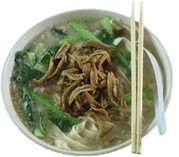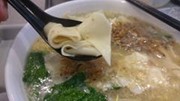**Shou Gong Mian 手工面 **means handmade noodle in Chinese and, it is one of those comfort food for local Chinese community in Singapore and Southern Malaysia (particularly in Johor Bahru). It is comparable to pasta for the western world, except it is not as widely available across the globe. This is something in must-try list for travellers to this part of the world.
You may noticed some other names for this dish such as Ban Mian, You Mian and Mee Hoon Kueh, but it is more or less referring to the noodle which is handmade into different shapes and sizes. Of course, the uniqueness of each variation lies on the texture of the noodle of which may differs for different people liking. There is nothing fanciful in the noodle's ingredients other than wheat flour and eggs. It is such simple combination that brings comfort to all which can be seen eating for breakfast, lunch and dinner (some for supper too!). The process of making the noodles definitely required some patience and strength as it required kneading (by hand please) and resting (for at least an 1 hour). The quality of noodle measured by its texture, smoothness and thickness of the noodle.

As much as we want the noodle to be handmade as the name signified, modern cities like Singapore will have many of it being factory-made (central kitchen) instead where the texture, size and shape are more or less consistent. However, you can still find those local stall where they still serve the noodle which is handmade by them exclusively (will provide some local recommendation at the end of the article). Noticeably the direct way to compare are those stalls selling Shou Gong Mian or Ban Mian in the neighbourhood hawker versus those in foodcourt in the large shopping centre. We would recommend you to try both to spot the differences between the 2 variations.
The concept of this dish is simple - soup in noodle. Apart from the noodle which mentioned earlier on its differentiation, the soup or broth sets apart good versus great Shou Gong Mian or handmade noodle. There many variation of the broth ranging from pure pork-base to seafood-base, however the key ingredients of all is the Ikan Bilis (dried anchovies) which brings out the sweetness and fragrant of the soup. You can definitely taste the different with or without Ikan Bilis and thus it is the unsung hero for the dish. It works well for any soup stock - chicken, pork, prawn or seafood, but then again the quality and freshness of the Ikan Bilis also play a part. Other ingredients such as mushroom, spinach and garlic are optional added flavour for the dish.
Nowadays, you can even find the dried version of this dish (and surprisingly popular too!) of which I would say, it is nice but would prefer to upkeep the traditions of soup-based Shou Gong Mian (handmade noodle).

How to make your own Shou Gong Mian 手工面 ? Stay tune for Part 2 of my article. (pls follow me and subscribed ya :D much appreciated).
#foodie #foodies #EatLikeAsians #handmade #soup #noodle #singapore #malaysia #handmadenoodle #recipe